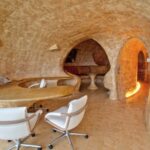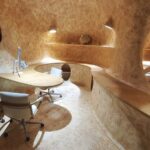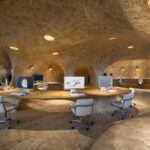Introduction
In the fast-paced modern world, architects like Javier Senosiain are reimagining workspaces to create environments that are both functional and emotionally enriching. The Cave Office is a testament to this vision, offering a space that blends comfort, creativity, and a deep connection to natural forms.

Concept and Inspiration
The Cave Office is designed to break away from the traditional glass box architecture. Inspired by natural shelters such as the maternal womb, animal burrows, and igloos, Senosiain aimed to create spaces that feel intimate and protective. This concept, known as bioarchitecture, seeks a thoughtful reconciliation with nature rather than a mere return to primitive forms.
Zoning and Spatial Organization
The office is divided into two main areas: the private zone and the workshop zone, connected by a winding tunnel. This layout not only enhances the sense of exploration and discovery but also provides distinct areas for different functions.

Workshop Area
The workshop is a spacious area designed for collaborative work. It features two large tables, one for computer-aided design and the other for physical model making. This setup encourages interaction among creative staff, fostering a dynamic and collaborative environment.
Multipurpose Terrace
Adjacent to the workshop is a versatile terrace, offering a place for eating, resting, or working. This terrace provides a vital connection to the outdoors, allowing staff to enjoy green spaces and urban views, enhancing their overall well-being and creativity.
Private Area
The private area comprises two cubicles designed to resemble caves and a circular meeting room. These spaces provide the necessary privacy for focused work and intimate meetings, whether for internal team discussions or client presentations.

Materials and Construction
Originally, the space was a rectangular prism with square walls and windows. To redefine this space, pine wood skeletons were constructed transversely and covered with thin strips in the opposite direction. The final finish includes maple root veneer on the walls, ceilings, and floors, with leather-covered work surfaces for a comfortable, tactile experience.
Sensory Experience
Working in the Cave Office is akin to being in a warm, illuminated cave. The use of natural materials and thoughtful design elements create sensory stimuli that vary throughout the day, enhancing the workspace’s dynamic and pleasant atmosphere.
Conclusion
The Cave Office by Javier Senosiain exemplifies a harmonious blend of nature and innovation. By creating spaces that are both functional and emotionally resonant, Senosiain offers a new perspective on office design—one that prioritizes human comfort, creativity, and a deep connection to the natural world.
















